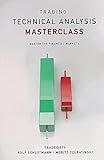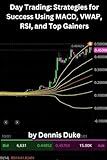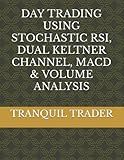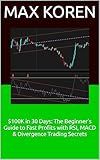Best Books on MACD Strategies to Buy in December 2025

Trading with MACD: The Ultimate Stock Market Strategy (Advanced Trading Strategies Collection: Step by Step Guide for Success in Stock Market Trading)



Trading: Technical Analysis Masterclass: Master the financial markets
- MASTER TECHNICAL ANALYSIS TO UNLOCK FINANCIAL MARKET SUCCESS.
- LEARN FROM A PREMIUM-QUALITY BOOK DESIGNED FOR TRADERS.
- ELEVATE YOUR TRADING SKILLS WITH EXPERT INSIGHTS AND STRATEGIES.



Day Trading: Strategies for Success Using MACD, VWAP, RSI, and Top Gainers



MACD Strategies for Crypto Trading: Master Technical Indicators & Boost Profits in Bitcoin & Altcoin Markets



Two Roads Diverged: Trading Divergences (Trading with Dr Elder Book 2)



MACD Secrets: A Deep Dive into Market Mastery: Unveiling Proven Strategies of MACD for Consistent Profits



DAY TRADING USING STOCHASTIC RSI, DUAL KELTNER CHANNEL, MACD & VOLUME ANALYSIS



DAY TRADING STRATEGY USING FRACTAL CHAOS BANDS, CAMARILLA PIVOT POINTS, MACD & KAUFMAN'S EFFICIENCY RATIO



$100K in 30 Days: The Beginner’s Guide to Fast Profits with RSI, MACD & Divergence Trading Secrets


The Moving Average Convergence Divergence (MACD) is a popular technical indicator used in day trading to identify potential buy and sell signals. It is a versatile indicator that combines elements of moving averages and momentum oscillators.
To use MACD for day trading, you must understand its components and how to interpret them on price charts. The MACD indicator consists of three main elements:
- MACD Line: This line represents the difference between the 12-period and 26-period exponential moving averages (EMA) of the price. It helps to identify the trend and measure its strength.
- Signal Line: The 9-period EMA of the MACD Line forms the signal line. It acts as a trigger for potential buy and sell signals. When the MACD Line crosses above the signal line, it generates a bullish signal, and when it crosses below the signal line, it generates a bearish signal.
- MACD Histogram: It represents the difference between the MACD Line and the Signal Line. The histogram oscillates above and below a zero line, indicating the momentum of the price movement. Positive values above the zero line suggest bullish momentum, while negative values below the zero line indicate bearish momentum.
To use MACD for day trading, follow these steps:
- Plot the MACD indicator on your price chart. Most trading platforms have built-in MACD indicators that can be easily added.
- Identify potential buy signals when the MACD Line crosses above the Signal Line from below. This crossover suggests a bullish trend and may be a good opportunity to enter a long position.
- Look for potential sell signals when the MACD Line crosses below the Signal Line from above. This crossover indicates a bearish trend and may be an indication to exit a long position or enter a short position.
- Use the MACD Histogram to confirm the strength of the trend. A widening histogram suggests growing momentum, while a narrowing histogram indicates slowing momentum. Positive or negative values give additional insights into the strength of the trend.
- Consider using additional technical analysis tools to confirm MACD signals. This could include support and resistance levels, trendlines, and other indicators.
Remember, like any technical indicator, MACD is not foolproof and should be used in conjunction with other analysis techniques and risk management strategies. It is important to practice and gain experience using MACD in different market conditions before relying solely on it for day trading decisions.
What is the relationship between moving averages and MACD?
Moving averages and MACD (Moving Average Convergence Divergence) are both technical indicators commonly used in financial analysis to evaluate trends and generate trading signals. The relationship between them can be understood as follows:
- Moving Averages: Moving averages are used to smooth out price data and identify trends over a specific period. They are calculated by averaging the closing prices of a specified number of periods. Moving averages can be simple (SMA) or exponential (EMA). They help in identifying support and resistance levels and can signal trend changes.
- MACD: MACD is a trend-following momentum indicator that consists of two lines and a histogram. The MACD line is calculated by subtracting the 26-day EMA from the 12-day EMA. The signal line is a 9-day EMA of the MACD line. The histogram represents the difference between the MACD line and the signal line. MACD helps traders identify potential buy and sell signals, divergences, and bullish or bearish market conditions.
The relationship between moving averages and MACD is that the MACD line is derived from the moving averages. The MACD line uses the difference between two moving averages (12-day and 26-day EMAs) to help identify potential trend changes. When the MACD line crosses above or below the signal line, it generates buy or sell signals. Additionally, the MACD histogram provides visual representation of the convergence or divergence between the MACD line and the signal line, helping to identify potential reversals.
In summary, moving averages are used to calculate the MACD line, and the MACD line, along with its signal line and histogram, helps traders in identifying trends, generating buy/sell signals, and capturing potential market reversals.
How to incorporate MACD into a risk management strategy?
Incorporating Moving Average Convergence Divergence (MACD) into a risk management strategy can help traders make informed decisions by identifying potential trend reversals and generating buy/sell signals. Here are a few steps to incorporate MACD into your risk management strategy:
- Understanding the MACD: Familiarize yourself with the components of MACD: two moving averages (fast and slow) and a histogram. The fast-moving average tracks short-term price movements, the slow-moving average tracks long-term price trends, and the histogram represents the difference between them.
- Identify Trend Reversals: MACD can help identify potential reversals in trends. When the MACD line crosses above the signal line, it is considered a bullish signal indicating a potential uptrend reversal. Conversely, when the MACD line crosses below the signal line, it is a bearish signal indicating a potential downtrend reversal.
- Use MACD Histogram: The histogram in MACD shows the difference between the MACD line and the signal line. A rising histogram indicates increasing momentum, while a falling histogram suggests decreasing momentum. By monitoring the histogram, you can identify potential shifts in market sentiment.
- Combine with Other Indicators: MACD should be used in conjunction with other risk management and technical analysis tools. Combining MACD with indicators like support and resistance levels, trendlines, or other oscillators can provide a more comprehensive view of the market and minimize false signals.
- Set Risk Parameters: Determine risk levels before entering a trade. This may involve setting stop-loss orders or taking profit targets based on key support/resistance levels or previous market swings. MACD can help confirm or invalidate your risk parameters by indicating whether the trend is gaining or losing strength.
- Consider Timeframes: MACD can be used on various timeframes, but it's essential to match it with your trading strategy. Short-term traders may use lower timeframes to catch smaller price moves, while long-term investors may rely on higher timeframes for more reliable signals.
- Track MACD Divergences: MACD divergences occur when the price moves in the opposite direction of the MACD indicator. Bullish divergence happens when the price makes lower lows, but the MACD creates higher lows. Bearish divergence is the opposite. These divergences can indicate potential trend reversals.
Remember, incorporating MACD into a risk management strategy involves understanding the indicator, combining it with other tools, and setting risk parameters based on your trading preferences and market analysis. Regularly review and refine your risk management strategy to adapt to changing market conditions.
How to backtest MACD strategies for day trading?
To backtest MACD strategies for day trading, you can follow these steps:
- Choose a trading platform: Select a platform that allows you to backtest strategies using historical data. Examples include MetaTrader, TradingView, or dedicated algorithmic trading platforms.
- Define the MACD strategy: Determine the specific rules and parameters for your MACD strategy. This may include entry and exit conditions, trade management rules, and risk management parameters.
- Gather historical data: Obtain high-quality historical price data for the assets you wish to backtest. Ensure that the data includes accurate timestamped price series data, including opening, closing, high, and low prices for each day.
- Program your strategy: Utilize the programming capabilities of your chosen platform to code your MACD strategy. This will involve implementing the specific rules and conditions for your strategy using the platform's built-in scripting language or programming interface.
- Set up backtesting environment: Configure your platform to use the historical data you gathered and the parameters you defined for your MACD strategy. This will allow the platform to simulate the execution of trades based on your strategy over the historical data.
- Run the backtest: Initiate the backtest and allow the platform to test your MACD strategy using the historical data. This process will calculate the theoretical trades and outcomes, including profits or losses, based on your strategy's rules and parameters.
- Analyze the results: Review the performance metrics generated by the backtest. This will include metrics such as total return, win rate, average profit/loss per trade, drawdowns, and other relevant statistics. Analyze the results to assess the effectiveness of your MACD strategy.
- Optimize and refine: Based on the results of your backtest, modify the strategy parameters and rules to improve its performance. This iterative process may involve adjusting entry/exit conditions, timeframes, or other variables to identify more profitable settings.
- Validate results: After optimizing your strategy, conduct additional backtests to validate that the changes made have improved performance consistently. Ensure that the strategy is not overfitting on past data by testing it on out-of-sample data or using walk-forward analysis.
- Live testing: Once you are satisfied with the performance of your MACD strategy through backtesting, consider implementing it in a live trading environment using real-time market data. Always start with small position sizes and carefully monitor the strategy's performance before considering it for larger trades.
Note: Backtesting is a valuable tool for strategy development, but it does not guarantee future performance. Market dynamics, liquidity, and other factors may influence actual trade execution and outcomes.
